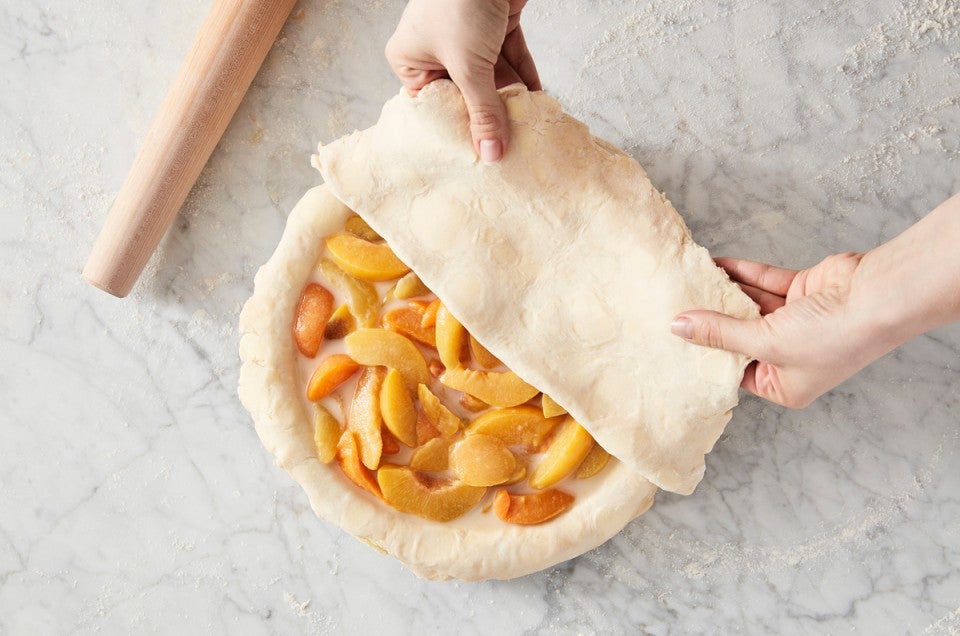


Do you suffer from pie crust phobia? If so, you’re not alone; plenty of otherwise confident bakers find themselves furtively hustling a ready-made crust out of the supermarket freezer case into their shopping cart. But life doesn’t have to be that way; you can make the best pie crust ever by following these simple steps:
We’ve written plenty about pie crust technique; our Perfect Pie Crust guide is a wealth of practical information, including links to foolproof recipes.
What I want to emphasize here is the importance of your ingredients: specifically flour, salt, fat, and liquid. Choosing those four ingredients wisely will lead to consistently great pie crust.
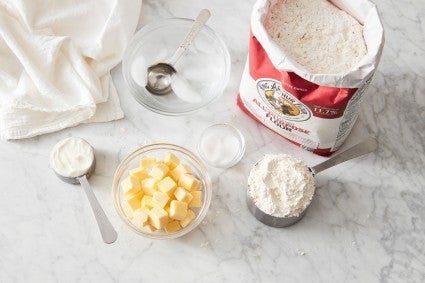
What kind of flour makes the best pie crust?
Well, not high-protein bread flour! Use that for your chewy bagels. What you want for pie is flour that yields a tender, flaky crust, which means medium-protein all-purpose flour or low-protein pastry flour.
When you add water to flour some of its protein turns into gluten, an elastic substance that gives baked goods the structure they need to hold together (and to rise when appropriate). The higher the protein level, the stronger the structure. (Learn more here: Protein percentage in flour: Why it matters.)
Strong structure in yeast bread translates to high-rising; but in pie crust, strong structure can be perceived as tough — the last attribute you want applied to your apple pie. So stick to flour with a medium-to-low percentage of protein, which means all-purpose flour (11.7% protein), pastry flour blend (10.3%), or pastry flour (8.0%).
Not necessarily. Yes, you can make tender, flaky pie crust with pastry flour. But it can be a bit of a challenge, particularly for those uncertain of their pie crust skills. Pastry flour pie crust is harder to roll without cracking, and it can split apart at the seams while the pie is baking.
That’s why I choose all-purpose flour for my pie crust. The dough is easier to roll out and move around and, despite its slightly higher protein, the crust is wonderfully flaky. In my book, the ease of an all-purpose flour crust trumps the marginal added tenderness of a pastry flour crust.
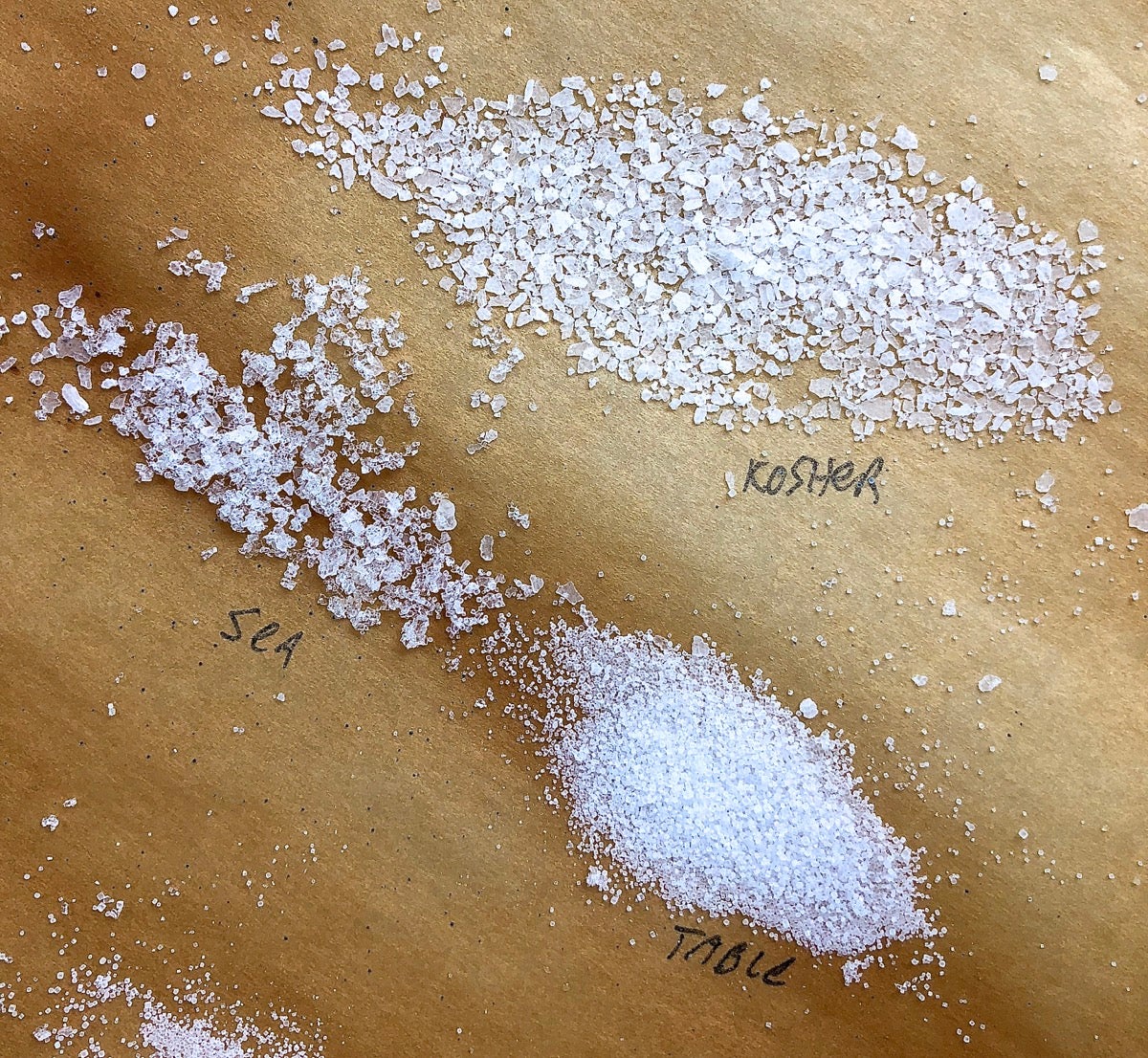
Salt adds flavor to pie crust. Leave out the salt and, unless you’re used to following a salt-free diet, the crust will taste like cardboard.
I find that when using unsalted butter and/or shortening in your crust, about 1/2 teaspoon salt per cup of flour is just perfect. If you're using salted butter, reduce the amount of added salt in your crust by 1/4 teaspoon for each 8 tablespoons (1/2 cup) of butter in the recipe.
Now, which salt is best? Kosher, flaky sea salt, table salt, or fine salt?
Since pie crust dough has very little liquid, choose table salt or fine salt. Their finer crystals will disperse more evenly throughout the dough despite the lack of water to dissolve them.
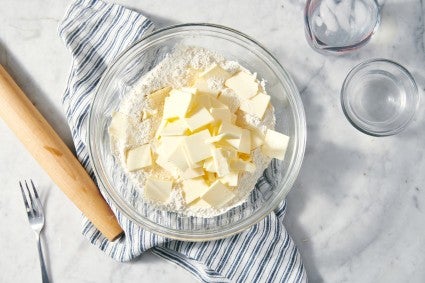
Some people love lard in pie crust. Others use liquid vegetable oil. There are those who swear by their grandma’s Crisco crust — and other bakers who eschew solid vegetable shortening for health reasons. Many people love an all-butter crust. And then there’s coconut oil … So many choices!
The best fat for pie crust? All will work, so it’s flavor preference and your own dietary choices. I alternate between an all-butter crust and one that’s part vegetable shortening, part butter.
Why the combination? Butter is a major flavor enhancer, but its low melting point can be an issue. Shortening, with its higher melting point, adds stability to a baking pie crust.
If you have trouble with your crust slipping down the sides of the pan, or if your carefully fashioned crimp around the edge melts and puddles, blame butter. A combination of butter and shortening yields the best qualities of each: flavor and baking stability.
Want to learn more about these two fats? See Butter vs. shortening: the great pie crust bakeoff.
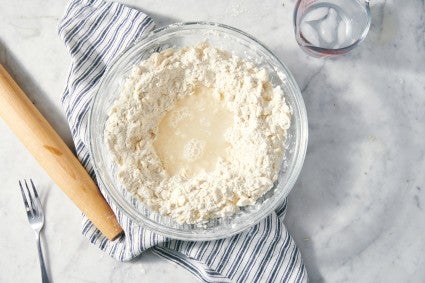
As mentioned before, liquid + the protein in flour = gluten. And once that gluten forms, working it — by mixing the pie crust dough, then rolling it out — increases gluten’s strength and decreases the resulting crust’s tenderness.
The best pie crust is a perfect balance between fat, flour, and liquid. Too much fat and the crust may taste greasy and crumble as it bakes. Too much liquid can create extra gluten, leading to tough, chewy crust.
But strike just the right balance — sufficient fat for tenderness without greasiness, and just enough liquid to hold everything together — and you’ve struck pie crust gold.
Some bakers use milk or buttermilk in their pie crust. Thanks to their milk solids, both will help crust brown and add a bit of tenderness.
But the classic liquid in pie crust is water — ice water, to be precise.
Why ice water? Ice water keeps the bits of fat in the dough cold and intact (rather than melted and dispersed). This creates little pockets of fat that, as the pie bakes, gradually melt and form tiny caverns in the crust — which we describe as flakiness.
Vodka in pie crust has been a popular substitute for ice water in recent years. Why? It’s said that its lower percentage of water (alcohol is part water, part ethanol) means less gluten development, yielding a more tender crust.
In my experience this is partially true; using vodka in pie crust makes a soft, silky dough that’s lovely to roll out. But the resulting crust isn’t any more tender or flaky than an ice-water crust.
And crust whose liquid is 100% vodka can border on being too tender, since less of its gluten has been activated. An all-vodka crust (especially one made with higher-proof vodka) can occasionally fall apart as you move it from countertop to pie pan.
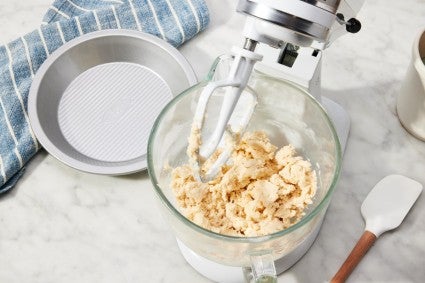
Less is more: The less liquid you add to pie crust dough (within reason), the more tender it will be.
Here’s my preferred way to add just enough liquid to pie crust. I typically make our Classic Double Pie Crust recipe (because if you’re making pie crust, you might as well make a double — you can always freeze one for later).
Once the fat, flour, and salt have been combined in my stand mixer (yes, my stand mixer; it’s easy and effective for making pie crust), I add a “nip” of vodka. You know, one of those little 50-ml. bottles.
When the vodka is thoroughly dispersed, I dribble in ice water just until the dough starts to come together. And I mean just enough water. Watch carefully as you stir; when the dough starts to clump, and you grab a handful and squeeze it and it doesn’t crumble into pieces, stop adding water.
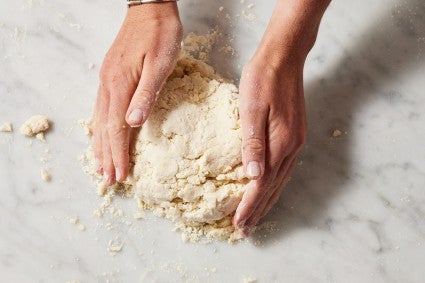
Gather the dough into a ball. Divide it in half, and flatten each half into a hockey puck-like disk.
That’s it. You’re done. You’ve just made the best pie crust for apple pie, pumpkin pie, [name your favorite] pie. Given correct handling (and you can check our pie crust guide for tips), your crust will be tender and flaky, golden brown and flavorful.
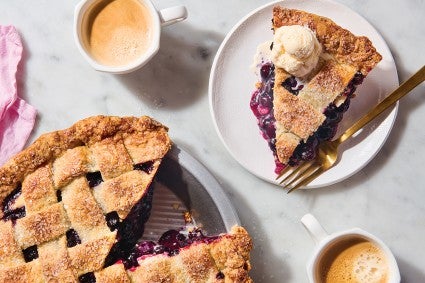
Still doubtful? Gather your ingredients and give our Classic Double Pie Crust a try. I doubt you’ll be heading back to the supermarket freezer case anytime soon!
Cover photo by Mark Weinberg.



October 27, 2019 at 3:16am
I use a gluten free cup for cup flour, but it always turns out very chewy. Is there something i need to do to this recipe when using this flour? like add more or less of something?Thank you in advance.
October 28, 2019 at 11:50am
In reply to I use a gluten free cup for… by Maribeth Francis (not verified)
Hi Maribeth! We aren't sure which cup for cup flour you're using, but with our Gluten-Free Measure for Measure Flour, one recipe that works really well is our Rustic Milk Pie Dough which (as the name would suggest) uses milk instead of water which really tenderizes the dough. While you certainly could mix it by hand, we've found that using a stand mixer is significantly easier (and certainly less frustrating) as mixing gluten-free pie crust can tend to be. We have a blog article with tips on making pie crust in a stand mixer if you're interested in giving that a try. Using this recipe and technique creates a gluten-free pie crust that rolls surprisingly well and you can even (carefully) make designs and lattices with. We hope you'll give it a try!
October 30, 2019 at 1:49am
In reply to I use a gluten free cup for… by Maribeth Francis (not verified)
Yes, I would like info. On making a better Gluten Free pie crust. I have GF all purpose flour to use cup for cup in measuring.
Please give the perfect recipe. Thank you.
October 30, 2019 at 12:09pm
In reply to Yes, I would like info. On… by Ardis Stubl (not verified)
Hi there, Ardis! We have a great Gluten-Free Pie Crust recipe that uses our Gluten-Free All-Purpose Flour. Or, you if you have our Gluten-Free Measure for Measure Flour, we particularly enjoy our Rustic Milk Pie Dough recipe made with the Measure for Measure Flour in place of the all-purpose flour called for. Happy baking!
October 25, 2019 at 1:54pm
I have a recipe for Bolos Levedos which calls for vodka and I always wondered why. I guess I now know. Thank you.
September 10, 2019 at 7:00pm
I am new to this site. I am a long time baker ( not always great). Leaned quite a bit from your article. I am in Canada east coast( Nova Scotia). The stores don’t carry your products, my loss. Enjoyed this read.
November 17, 2018 at 7:51am
October 28, 2019 at 5:54pm
In reply to I have been omitting salt from pie crusts for years and been we… by Kathryn Godley (not verified)
I, too, never use salt in pie crust. I seldom use salt on anything other than potatoes or mushrooms. I'm afraid I would taste the salt in the crust, spoiling it for me.
October 29, 2019 at 12:21pm
In reply to I have been omitting salt from pie crusts for years and been we… by Kathryn Godley (not verified)
I enjoy your articles; especially the one on pie crusts. Also enlightened by the queries and replies.
October 29, 2018 at 10:57am
Pagination